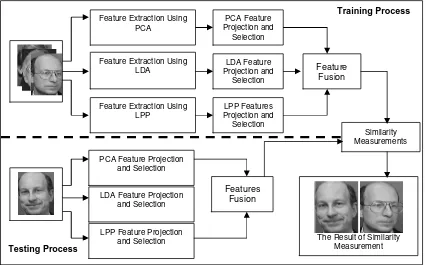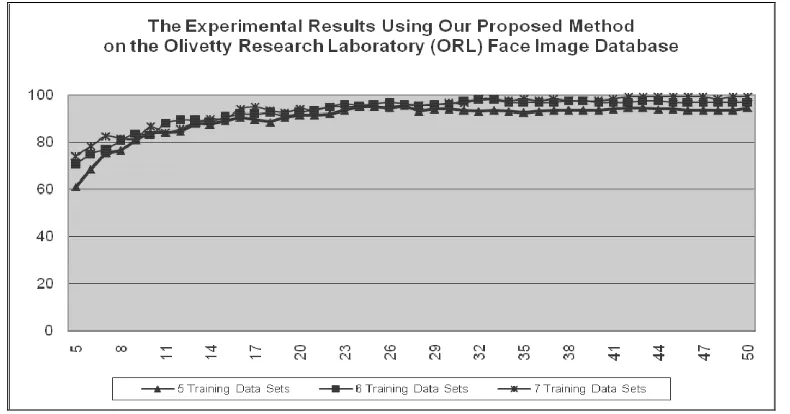ISSN: 1693-6930
accredited by DGHE (DIKTI), Decree No: 51/Dikti/Kep/2010 125
Appearance Global and Local Structure Fusion for Face
Image Recognition
Arif Muntasa*1, Indah Agustien Sirajudin2, Mauridhi Hery Purnomo3
1,2
Informatics Department, Fakultas Teknik Universitas Trunojoyo, Bangkalan, Indonesia
3
Electrical Engineering Department, Institut Teknologi Sepuluh Nopember, Surabaya Indonesia e-mail: [email protected]*1, [email protected], [email protected]
Abstrak
Analisis komponen utama (PCA) dan analisis deskriminan linear (LDA) merupakan metode ekstraksi berbasis penampakan yang menghasilkan fitur-fitur dengan struktur global. Fitur-fitur dengan struktur global mempunyai kelemahan, yaitu fitur-fitur dengan struktur lokal tidak dapat dicirikan. Proyeksi pelestarian lokalitas (LPP) dan wajah-Laplacian orthogonal (OLF) merupakan metode ekstraksi model penampakan yang menghasilkan fitur-fitur dengan struktur lokal, namun fitur struktur global diabaikan. Baik fitur dengan struktur lokal maupun global adalah sama-sama penting. Sehingga ekstraksi menggunakan fitur struktur lokal atau global saja tidak cukup. Pada penelitian ini, diusulkan metode ekstraksi berbasis penampakan yang menggabungkan fitur-fitur dengan struktur global dan lokal. Hasil ekstraksi untuk metode penampakan PCA dan LDA digabungkan dengan hasil ekstraksi dari proyeksi pelestarian lokalitas. Hasil pemodelan telah diuji dengan citra wajah basisdata Olivetty Research Laboratory. Hasil eksperimen menunjukkan bahwa metode yang diusulkan telah mencapai akurasi pengenalan yang lebih tinggi dibandingkan metode PCA, LDA, LPP dan OLF.
Kata kunci: LDA, PCA, pengenalan wajah, penyatuan fitur, struktur lokal dan global
Abstract
Principal component analysis (PCA) and linear descriminant analysis (LDA) are an extraction method based on appearance with the global structure features. The global structure features have a weakness; that is the local structure features can not be characterized. Whereas locality preserving projection (LPP) and orthogonal laplacianfaces (OLF) methods are an appearance extraction with the local structure features, but the global structure features are ignored. For both the global and the local structure features are very important. Feature extraction by using the global or the local structures is not enough.In this research, it is proposed to fuse the global and the local structure features based on appearance. The extraction results of PCA and LDA methods are fused to the extraction results of LPP. Modelling results were tested on the Olivetty Research Laboratory database face images. The experimental results show that our proposed method has achieved higher recognation rate than PCA, LDA, LPP and OLF Methods.
Keywords: face recognition, feature fusion, global and local structure, LDA, PCA
1. Introduction
local structures. These features are sorted in descending order and fused from the most to the least dominant feature.
2. Proposed Method
In this research, we devide two main processes, which are the training and the testing processes. On the training process, training sets are extracted by PCA, LDA and locality preserving projection (LPP). The results of feature extraction are projected and selected. The selection results of the training process are re-fused into a whole feature. Whereas on the testing process, testing set is projected on each of the projection results of the training sets and selected according to the number of results in the the training sets selection. Similarly, the features on the testing set can be achieved by re-fusing of the feature selection. To recognize face images, similarity measurement is conducted by comparing to features on each the training and the testing sets resulted as shown in Figure 1.
Figure 1. The Proposed Method System
2.1. Feature Extraction by Using Principal Component Analysis
Kurhunen-Loeve is linear technique used to project the higher into the lower dimension data. It is called as Principal Component Analysis (PCA) [10], [11], [17]. If an image dimension is represented by using n (image row x coloumn) and number of training set used is m, in this case m<<n, then it can be expressed by using the following
The average of all training set can be written by using the following equation Feature Extraction Using
PCA
Feature Extraction Using LDA
Feature Extraction Using LPP
PCA Feature Projection and Selection
LDA Feature Projection and Selection
LPP Feature Projection and Selection
Features Fusion
The Result of Similarity Measurement
Training Process
]
The result of Equation (4) has m dimension, where m<<n, so the minimum number of dimension reduction obtained is n - m [10], [11].
2.2. Feature extraction by using Linear Descriminat Analysis
Linear Descriminant Analysis (LDA) is improvement of PCA process, LDA is used to maximize the difference of between-class ratio and minimize within-class ratio [5], [8]. The largest between-class ratio and the smallest within-class ratio obtained, the feature extraction resulted is the better. The difference of LDA ratio can be expressed by using the following
2.3. Feature Extraction by Using Locality Preserving Projection
than global structure features [2]. LPP seeks to preserve the intrinsic geometry of the data and the local structures. Objective function of LPP can be expressed by using the following equation
∑
−W is similarity matrix and it can be written by using the following equation
j vector can be achieved by solving minimization of the following equation
a
eigenvector can be formulated by using the following equationa XDX a
XLXT =λ T (12)
2.4. Feature Selection and Fusion of the Extraction Result by Using PCA, LDA and LPP Fusion of feature extraction results is usually conducted on an appearance global expressed by using the following equation
ΛPCA =[Λ1,1; Λ1,2; ...;Λ1,m] (13)
ΛLDA =[Λ2,1; Λ2,2; ...;Λ2,m] (14)
ΛLPP = [Λ3,2; Λ3,2;....;Λ3,m] (15)
If number of features extracted for each the feature extraction method is m, whereas the number of feature selection is S and S<m, than number of features fusion of PCA+LDA+LPP can be represented by 3S. Feature selection and fusion modelling can be shown in Figure 2. The result of feature fusion can be written in the following matrix
To simplify calculation, Equation (16) can be written in the row vector as shown in the following equation
Λfusion
Equation (17) is fusion feature of PCA, LDA as the global structures and LPP as the local structures.
Figure 2. Selection and Fusion Features of the Extraction Results
3. Similarity Measurement
To deterimine the classification results, it is necessary to be conducted similarity measurement based on feature fusion. It can be written in the following equation
(
)
| |
| |
| |
,
Testing Training
Testing Training
Testing Training
d
Λ + Λ
Λ − Λ
= Λ
Λ (18)
Recognition rate percentage resulted can be calculated by dividing number of true recognition results to number of the testing sets as written in the following equation
% 100 _
Re x
stingSets NumberOfTe
fication TrueClassi Rate
cognition = (19)
4. Experimental Results and Analysis
Figure 3. Sample of Olivetty Research Laboratory Face Image
4.1. Experimental Scenarios
To compare the experimental results, we perform 3 scenarios. The first scenario, number of training sets used was 5 poses for each person and the remaining 5 poses were used as testing set. The second scenario, number of training sets was increased to 6 poses for each person and the remaining 4 poses were used for testing set. And the last scenario, number of training sets used was 7 poses and the remaining 3 poses were used as testing set. Whereas number of features used to measure the similairity is 5 to 50 features for each method
4.2. Results and Analysis
The experimental results of the first scenario can be shown in Figure 4. The more number of dimensions used, the higher recognition rate percentage achieved. This phenemonen also appeared on the second and the last scenarios. The more number of training sets used, the higher recognition rate percentage obtained.
Figure 4. The Experimental Results Using Our Proposed Method On The Olivetty Research Laboratory (ORL) Face Image Database
quantities due to the number of dominant features that are not used as a measurement of similarity. It can be prooved by increasing in the recognition rate percentage when the features used to measure similarity were increased. Maximum recognition rate for each scenario can be shown in Table 1. The maximum recognition also tends to rise in accordance with the amount of training data used. The experimental results have also compared to other methods, such as PCA, LDA, LPP and OLF as shown in Table 2. We have compared our proposed method with other method such as PCA, LDA, LPP and OLF on the ORL face image database. Comparison results show that the proposed method has obtained higher recognition rate than other method the maximum recognition also tends to rise in accordance with the number of training sets used.
Table 1. The maximum Recognition Rate on the Olivetty Research Laboratory Face Image Database by Using Our Proposed Method
Scenario Number of the training Sets
The order of the training Set
The order of the testing Set
The maximum experimental results
achieved (%)
Dimension Used
1 5 1,3,5,7,9 2,4,6,8,10 95.50 27
2 6 1,3,5,7,9,2 4, 6, 8,10 98.13 32
3 7 1,3,5,7,9,2,4 6,8,10 99.17 42
Table 2. Comparison of the Recognition Rate on the Olivetty Research Laboratory Face Image Number of Training
Sets PCA LDA LPP
Orthogonal
Laplacianfaces Our Proposed Method
5 76,50% 94,44% 83,00% 91,50% 95,50%
6 81,25% 95,62% 90,63% 97,50% 98,13%
7 87,50% 98,83% 92,50% 99,17% 99,17%
5. Conclusion
Based on the experimental results on the ORL face database can be concluded Our proposed method “the Gobal (PCA and LDA) and the local structure features (LPP) fusion” of the extraction results based on appearance have increased the percentage rate for face image recognition. Fusion of appearance global and local structure dominant features can achieve higher recognition rate than PCA, LDA, Locality Preserving Projection and Orthogonal Laplacianfaces. The recognition results of our proposed method were influenced by number of training sets and dimensions used. The more number of training sets and dimensions used, the higher recognition rate achieved.
References
[1] Cai D, He X, Han J, Zhang HJ. Orthogonal laplacianfaces for face recognition. IEEE Transactions on ImageProcessing, 2006, 15(11): 3608–3614.
[2] He X, Yan S, Hu Y, Niyogi P, Zhang HJ. Face recognition using laplacianfaces. IEEE Transactions on PatternAnalysis and Machine Intelligence. 2005, 27(3):328–340.
[3] Cai D, He X, Han J. Using Graph Model for Face Analysis. University of Illinois at Urbana-Champaign and University of Chicago. 2005.
[4] Kokiopoulou E, Saad Y. Orthogonal Neighborhood Preserving Projections. University of Minnesota. Minneapolis. 2004.
[5] Yambor WS. Analysis of PCA-Based and Fisher Discriminant-Based Image Recognition Algorithms. Tesis of Master. Colorado: Colorado State University; 2000.
[6] Syaid AK. The Discrete Cosine Transform (DST): Theory and Application. Department of Electrical & Computer Engineering Michigan State University. 2003.
[7] Batur AU, Hayes MH. Linear Subspace for Illumination Robust Face Recognition. Proc. IEEE Int’l Conf. Computer Vision and Pattern Recognition. Atlanta. 2001: II-296.
[8] Mika S, R¨atsch G, Weston J, Sch¨olkopf B, Mller KR. Fisher discriminant analysis with kernels. IEEE Workshop on Neural Networks for Signal Processing IX. Berlin. 1999: 41-48.
[9] Muntasa A, Hariadi M, Purnomo MH. Automatic Eigenface Selection For Face Recognition. The 9th Seminar on Intelligent Technology and Its Applications. Surabaya. 2008: 29-34.
[11] Turk MA, Pentland AP. Face Recognition Using Eigenfaces. IEEE Conf. on Computer Vision and Pattern Recognition. Cambridge.1991. 586-591.
[12] Belhumeur JHPN, Kriegman D. Eigenfaces vs. fisherfaces: Recognition using class specific linear projection. IEEE Trans. on PAMI. 1997; 19(7): 711–720.
[13] Research Center of Att, UK, Olivetti-Att-ORL FaceDatabase,
http://www.uk.research.att.com/facedatabase.html. last accessed date: 9 Oct 2009.
[14] Made N, Sulaiman R. Sistem Pengenalan Wajah Pada Subruang Orthogonal Dengan Menggunakan Laplacianfaces Terdekomposisi Qr, Seminar nasional Pasca Sarjana VI. ITS Surabaya. 2006. [15] Zhao W, Chellappa R, Krishnaswamy A. Discriminant Analysis of Principal Components for Face
Recognition. Proc. Of the 3rd IEEE International Conference on Automatic Face and Gesture Recognition. Nara, Japan. 1998: 336-341.
[16] Lu X, Wang Y, Jain AK. Combining classifiers for face recognition. ICME International Conference on Multimedia and Expo. Maryland. 2003: 13-16.


